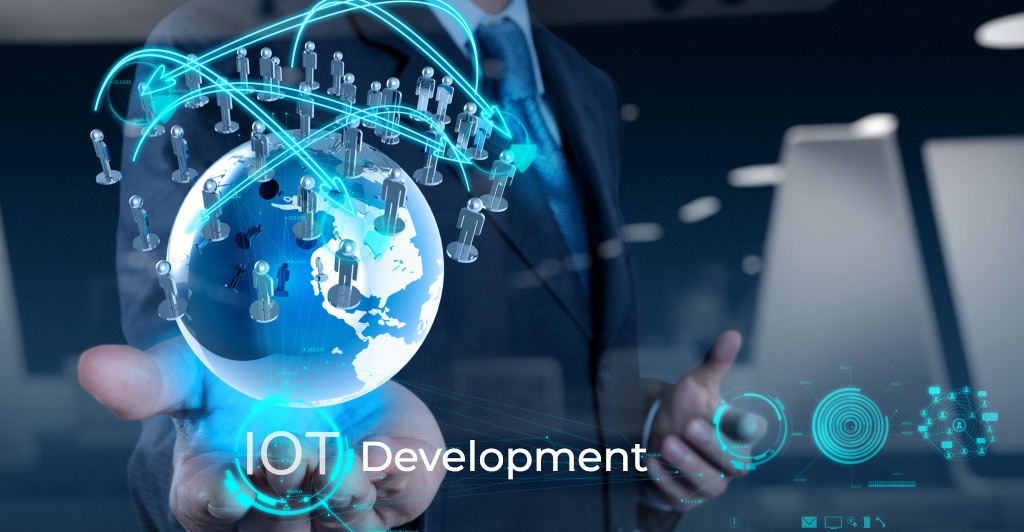
24 Mar Exploring the Benefits of IoT Development
The Benefits of IoT Development: Unlocking the Potential for Your Business
If you’re looking to stay ahead of the competition, investing in IoT development is a smart move. With IoT services and solutions, businesses can collect and analyze data to improve operations, increase efficiency, and enhance customer experience. In today’s interconnected world, businesses of all sizes are turning to the Internet of Things (IoT) to gain a competitive advantage. IoT development is the process of creating smart, connected devices that can collect and transmit data to enable new services and insights. By leveraging IoT services and solutions, businesses can improve efficiency, reduce costs, make better decisions, and enhance customer experience. In this blog post, we’ll explore the basics of IoT development, potential use cases and the benefits of investing in professional IoT development. We will also examine the challenges of IoT development and provide strategies for overcoming them. Plus, we’ll discuss the benefits of investing in professional IoT development to help unlock the potential of IoT for your business.
Understanding the Basics of IoT Development
IoT development involves connecting physical devices with sensors, gateways, and cloud platforms to create an ecosystem that can collect, store, and process data. IoT architecture typically includes four layers:
Sensors and Actuators: These are physical devices that collect data from the environment or control it.
Connectivity: This layer provides communication between the sensors and other devices in the network, including gateways and cloud platforms.
- Cloud Platform: This layer collects and processes the data and provides analytics and storage capabilities.
- Applications: This layer includes software applications that interact with the cloud platform to provide insights and services.
IoT development requires expertise in hardware design, software development, data analytics, and cloud computing. Developers also need to be familiar with IoT protocols and standards, such as MQTT, CoAP, and Zigbee, and IoT platforms and tools, such as AWS IoT, Azure IoT, and Google Cloud IoT.

Identifying Potential Use Cases for IoT Development
IoT development has numerous potential use cases across various industries. For instance, in healthcare, IoT devices can help monitor patient health remotely, track inventory and supplies, and optimize resource utilization. In agriculture, IoT devices can monitor crop health, soil moisture, and weather conditions to improve yield and reduce waste. In manufacturing, IoT devices can improve supply chain visibility, enable predictive maintenance, and enhance worker safety. In retail, IoT devices can enable personalized marketing and enhance the shopping experience.
For example, in the healthcare industry, IoT devices can be used to monitor patient health remotely, track inventory and supplies, and optimize resource utilization. Wearable devices can track vital signs, medication adherence, and activity levels, providing physicians and caregivers with real-time data that can inform diagnosis and treatment decisions. IoT-enabled inventory management systems can track medication and supply levels and automatically reorder when inventory runs low, reducing waste and ensuring that patients have access to the necessary medications and equipment.
In agriculture, IoT devices can be used to monitor crop health, soil moisture, and weather conditions to improve yield and reduce waste. Sensors can be deployed in the field to collect data on temperature, humidity, soil moisture, and other environmental factors, which can be used to inform irrigation and fertilization decisions. Drones equipped with sensors and cameras can be used to monitor crop health and detect pests and disease early, enabling farmers to take action before significant damage occurs.
In manufacturing, IoT devices can improve supply chain visibility, enable predictive maintenance, and enhance worker safety. Sensors can be deployed on machines to collect data on performance and maintenance needs, which can be used to predict when equipment will require maintenance, reducing downtime and improving efficiency. IoT-enabled asset tracking systems can provide real-time visibility into the location and condition of goods in transit, reducing the risk of loss or damage. Wearable devices can monitor worker health and safety, detecting potential hazards and providing alerts when workers are at risk.
In retail, IoT devices can enable personalized marketing and enhance the shopping experience. IoT-enabled beacons can detect when customers enter a store and send personalized promotions and recommendations to their smartphones, improving engagement and sales. RFID tags can be used to track inventory levels and enable real-time replenishment, ensuring that products are always in stock. Smart shelves can detect when products are low or out of stock and automatically trigger restocking, reducing the risk of lost sales.
We will not be exaggerating when we say that identifying potential use cases for IoT development involves understanding the specific needs and challenges of various industries and businesses, and then determining how IoT technology can help address those needs and improve operations. As an expert IoT developer, I can help businesses identify the most promising use cases for IoT technology and develop customized solutions that meet their unique needs and goals.
Examining the Challenges of IoT Development
IoT development also poses several challenges, including security, interoperability, and scalability. Security is a significant concern in IoT development because connected devices are vulnerable to hacking and data breaches. Interoperability refers to the ability of different devices to communicate with each other, which can be challenging due to the lack of standardization. Scalability is another challenge, as IoT ecosystems can grow rapidly and require distributed architectures and edge computing.
Strategies for Overcoming Common IoT Development Challenges
To overcome these challenges, businesses should implement best practices for IoT security, such as using encryption, access control, and firmware updates. Interoperability can be achieved through the use of open standards, API integration, and data normalization. Scalability can be addressed through edge computing, distributed architectures, and containerization.
Exploring the Benefits of Investing in Professional IoT Development
While some businesses may attempt to develop their IoT solutions in-house, investing in professional IoT development can yield numerous benefits. Professional IoT development teams have the expertise and experience to develop high-quality, secure, and scalable solutions faster and with reduced risk. They can also provide end-to-end services, from hardware design to software development and cloud integration. By partnering with a professional IoT development team, businesses can leverage the latest IoT technologies and gain a competitive edge.
Conclusion
In conclusion, IoT development offers numerous benefits for businesses looking to enhance efficiency, reduce costs, make better decisions, and improve customer experience. Understanding its basics, identifying potential use cases, and overcoming common challenges can help businesses unlock the potential of IoT development. Investing in professional IoT development can also provide numerous advantages, including faster time to market, reduced risk, and access to the latest IoT technologies. By embracing it, businesses can stay ahead of the competition and transform their operations for the better.